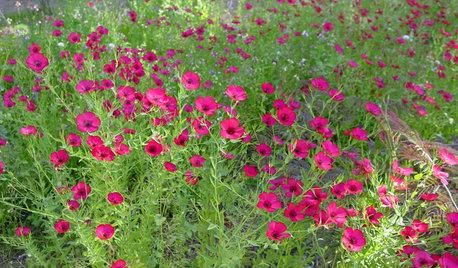Purpose of watering before fertilizing?
in_awe
9 years ago
Related Stories

GARDENING GUIDESGet on a Composting Kick (Hello, Free Fertilizer!)
Quit shelling out for pricey substitutes that aren’t even as good. Here’s how to give your soil the best while lightening your trash load
Full Story
FRONT YARD IDEASBefore and After: Front Lawn to Prairie Garden
How they did it: Homeowners create a plan, stick to it and keep the neighbors (and wildlife) in mind
Full Story
LIFE7 Things to Do Before You Move Into a New House
Get life in a new house off to a great start with fresh paint and switch plates, new locks, a deep cleaning — and something on those windows
Full Story
GARDENING GUIDESSouthwest Gardener's August Checklist
Manage monsoon effects, remember to fertilize and don't let the heat deter you from planting for fall
Full Story
HOUSEKEEPINGDon't Touch Another Stain Before You Read This
Even an innocent swipe with water may cause permanent damage. Here's what to know about how rugs and fabrics react
Full Story
GARDENING GUIDESCommon Myths That May Be Hurting Your Garden
Discover the truth about fertilizer, soil, staking and more to keep your plants healthy and happy
Full Story
GARDENING GUIDESHow to Switch to an Organic Landscape Plan
Ditch the chemicals for a naturally beautiful lawn and garden, using living fertilizers and other nontoxic treatments
Full Story
GARDENING GUIDESHow to Keep Your Citrus Trees Well Fed and Healthy
Ripe for some citrus fertilizer know-how? This mini guide will help your lemon, orange and grapefruit trees flourish
Full Story
GARDENING GUIDESPacific Northwest Gardener: What to Do in September
Put in cool-weather veggies, fertilize your lawn and tidy the garden this month before chilly weather arrives
Full Story
REMODELING GUIDESLinoleum, the All-Purpose Flooring Wonder
Dashing in a rainbow of colors, able to be cleaned with ease and courteous to budgets everywhere, linoleum is a super choice for floors
Full Story






Need2SeeGreen 10 (SoCal)
oxboy555
Related Professionals
Windham Landscape Architects & Landscape Designers · New Bedford Landscape Architects & Landscape Designers · Barrington Hills Landscape Architects & Landscape Designers · Eden Prairie Landscape Architects & Landscape Designers · Fitchburg Landscape Architects & Landscape Designers · Cicero Landscape Contractors · Shirley Landscape Contractors · Norton Solar Energy Systems · Melville Solar Energy Systems · Washington Window Contractors · Clermont Fence Contractors · Apache Junction Fence Contractors · Oceanside Fence Contractors · Safety Harbor Fence Contractors · Lomita Fence Contractorsdrew51 SE MI Z5b/6a
Need2SeeGreen 10 (SoCal)
oxboy555
tapla (mid-Michigan, USDA z5b-6a)
greenman28 NorCal 7b/8a
in_aweOriginal Author
greenman28 NorCal 7b/8a
oxboy555
calistoga_al ca 15 usda 9